Copyright 2018 Robert V. Goss
|
Monida & Yellowstone Stage Line - 1898-1913
Formed in 1898 by photographer Frank J. Haynes and Wm. W. Humphrey, the company received a 10-year lease from Interior to operate a stage line into and around Yellowstone. The new Monida & Yellowstone Stage Line provided service from the UPRR depot at Monida to the park, using red Concord stages from the Abbot Downing Company, and became known as the 'Red Line`. The route from Monida passed through Centennial Valley, past Henry`s Lake, over Targhee Pass, with an overnight stop at Dwelle`s Inn. This was a part of Harry Dwelle`s Madison Fork Ranch that was located about 5 miles west of the park border. Fountain Hotel was reached around noon the following day.
The Anaconda Standard of Feb. 3, 1898, reported that,"Forty thousand dollars will be expended this year in putting the line in shape. An order has been placed with the factory in New Hampshire [Abbot Downing] for 19 Concord coaches of the latest pattern as a starter for the equipment of the line. The horses, 150 head, will be purchased principally in Kentucky, some in Oregon. Everything will be in readiness for passenger business at the opening of the tourist season on the first of June. Mr. Humphrey will personally superintend the management of the new line."
Stables, barns, and driver`s quarters were located at eight different park locations. A brochure from the year 1900 boasts of a 6-day tour using two, four, and six-horse Concord coaches. Relay stations were placed every 15-20 miles along the Monida route. Hotel stops included two nights at Fountain and one night each at Lake, Canyon, and Mammoth hotels before exiting via Cinnabar.
Top: M-Y Sticker, photo from the author's collection.
Bot: M-Y Letterhead, 1899. Courtesy YNP Archive Collection
|
|
|
|
| A "Staged" Robbery - 1904 The Anaconda Standard, Aug. 9, 1904 |
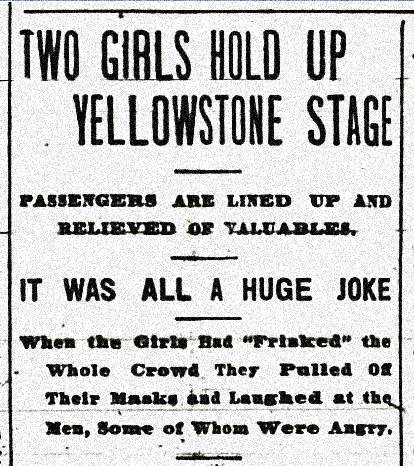 |
Special Dispatch to the Standard.
Billings, Aug. 8. - A man who was in Billings yesterday on his return from the National park related the story of a sham holdup of one of the stages that is operated from Monida to points in the park. While the whole affair was a hoax, this fact was not known to the passengers and it required considerable daring to carry it out. The sensational feature of the affair Is that the holdup is said to have been perpetrated by two young ladles, one of them the daughter of a prominent New York newspaper man and the other a Helena young lady. The name of the New York lady was remembered by the Standard's Informant on account of the prominence of her father, but he is unable to give the name of the Helena girl.
The young ladles were camping in the park with a party of friends and arranged with the driver of the stage to hold it up at a lonely point on the road. They attired themselves in regulation bandit costumes and rode out on horseback to the point agreed on, and when the stage arrived they drew down on the driver and he courteously came down from the box. The passengers, several of them being men, were compelled to line up at the side of the road and while one of the ''bandits” covered them with a rifle the other went through the party and appropriated money, jewelry and everything else of value that a diligent search revealed. |
| After they had secured everything in sight and had all the fun they wanted at the expense of the travelers, the young ladles pulled off their false whiskers and other disguises and gave the crowd the laugh. The valuables were restored, but several of the passengers were disposed not to regard the affair in the light of a joke and said they would make the girls trouble if there was any law that would reach them. The "sore" ones later concluded when their nerves had settled that such action would redound but little to their credit and they finally came around to see the ludicrous side of the affair and joined In the laugh. |
|
In the fall of 1907 the arrival of the Union Pacific rail line to the west entrance would end the long stagecoach haul from Monida and the company could begin picking up passengers at the new depot in Riverside (now West Yellowstone). The 1st passenger train arrived at the west entrance on June 11, 1908. The new passenger rail service was named the “Yellowstone Special” and a railroad car was used as depot the first year. The town was originally named Riverside, but the name was soon after changed to “Yellowstone.”
The stage company built new headquarters along the Madison River about 1-1/4 miles inside the park line. A 1908 map showed coach sheds, blacksmith and paint shops, corral, a barn and hay shed, office, lodging house, mess house, and granary. The Wylie Permanent Camping Company set up one of their stage operations and tent camp nearby the same year. In 1917 it was necessary to convert the buildings for use by the new White touring buses of the YPTCo. YPTCo built new facilities at Old Faithful in 1926, and the Barns fell into disuse. The buildings were razed in 1957.
Diagram of M-Y Barns and support buildings near to the West entrance .
Courtesy YNP Archives
|
|
 |
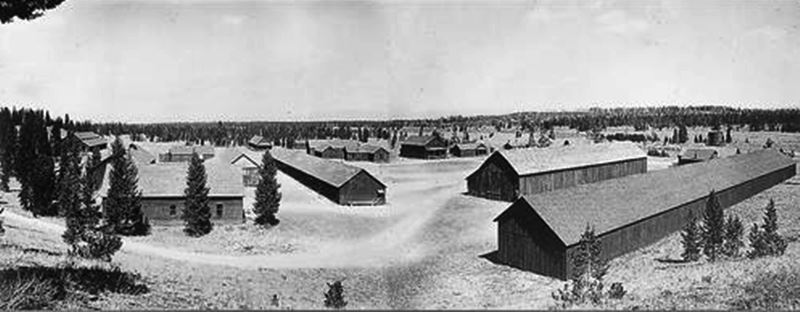 |
Top Photo: Line-up of Y-W stages at Canyon Hotel, 1914 Brochure, Author's Collection
Bottom Photo: "Riverside Barns" - Y-W facilities located just inside the West Entrance of Yellowstone
|
|
Yellowstone-Western Stage Co. - 1913-1916
F.J. Haynes bought out his partner Humphrey in 1913 and reorganized the Monida & Yellowstone Stage Co. into the Yellowstone-Western Stage Co. Haynes continued transporting visitors into the park from the UPRR depot at Yellowstone (West). By this time, the company already had facilities located at eight locations in the park. During the peak year of operation in 1915, the 'Red Line` (known for its red-colored Concord coaches), hauled 20,151 tourists (40% of the yearly total) into Yellowstone. Records also show, however that only 4116 passengers were carried in 1914 and 3659 in 1916. The fleet consisted of 45 eleven-passenger 4-horse coaches, 11 eight-passenger coaches, 13 three-passenger 2-horse surreys, and 61 five-passenger surreys. Two, four and five-day basic tours were available, ranging from $14.25 to $41.25. 2-horse surreys for three people could be rented with driver for $12.00/day.
After the 1916 season all of the transportation companies were consolidated into the YPTCo under the ownership of Harry Child. Haynes was forced to sell out his transportation holdings in Yellowstone & Western and the Cody-Sylvan Pass Motor Co. and was allowed only his photo shop operations in the park.
Top Right: Cover of 1916 Yellowstone-Western Brochure, Author's Collection
Bottom Right: Y-W metal driver's cap emblem, (from online auction)
|
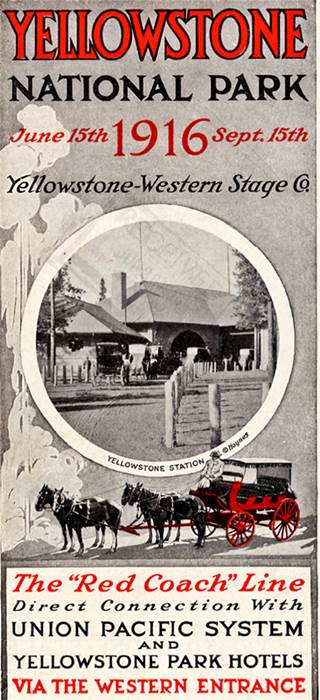 |
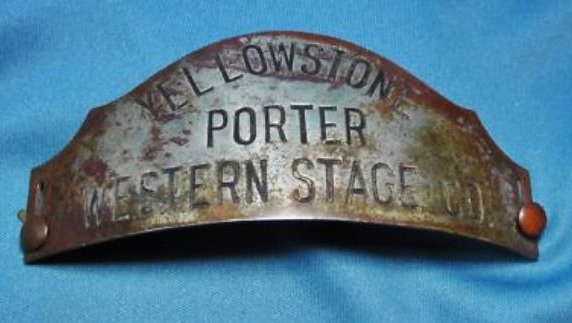 |
|
Yellowstone National Park Transportation Co. - 1891-1898
Yellowstone Park Association`s (YPA) transportation privileges were revoked Nov. 1, 1891 after Silas Huntley of Helena received the 10-year transportation franchise on March 29, 1891. He was allowed 14 months to begin operations by the Interior Dept. He brought in his brother-in-law Harry W. Child and Edmund Bach, Child’s brother-in-law. Together they formed the Yellowstone National Park Transportation Co. (YNPTCo) which was incorporated May 20, 1892 with capital of $250,000. Aaron and L.H.Hersfield were also partners in the operation.
In reality, YNPTCo actually began stage operations in March 1891 when George W. Wakefield lost his YPA contract. YPA then leased all of their transportation equipment and facilities to YNPTCo, who appointed Wakefield as President. A year later, the new company purchased the old Yellowstone Transportation Company and the Wakefield & Hoffman operations for $70,000 and was granted exclusive transport of NPRR passengers in Yellowstone National Park.
Right Top: YNPTCo Stage in front of the National Hotel at Mammoth Hot Springs, courtesy Stoddards Travelogues
Right Bottom: YNPTCo Stage, ca1895, courtesy YNP Archives #9055
|
|
|
|
The Red Lodge Picket, June 4, 1892
The Yellowstone National Park Transportation
company filed articles of incorporation Saturday
with the county clerk. With a capital of $250,000
it proposes to do ageneral transportation business
in the Park in the way of carrying passengers,
express and other matter. The company is made up
wholly of Helena men, its incorporators being L. H.
Herschfield, Aaron Herschfield, H. W. Child, S.S.
Huntley and E. W. Bach. |
The following February (1893), YNPTCo received leases for six parcels of land in Yellowstone to erect barns, corrals and other facilities. The company was later taken over by the Yellowstone Park Transportation Co. in 1898, under Harry Child, Silas Huntley, and Edmund Bach.
|
|
WANTED-THE YELLOW8TONE PARK Transportation Co. will give empioyment at $40 per month, bed and board furnished.
to 10 good, experienced four-horse stage drivers. Call on or address S. S. Huntley. General Manager, Mammoth Hot
Springs, Wyoming.
[Anaconda Standard, 5Jul1897]
|
Yellowstone Park Transportation Co. - 1898-1916
|
YPTCo Letterhead from 1904, courtesy YNP Archives
|
YPTCo Letterhead from 1907, courtesy author collection
|
|
Harry Child, Huntley, and Bach formed a new company called the Yellowstone Park Transportation Co. (YPTCo) in 1898 that took over the operation of the YNPTCo. They received a 10-year lease on March 31. Silas Huntley passed away three years later and his shares reverted to the NPRR’s North West Improvement Company (NWIC). Bach sold his shares to NWIC in 1902 due to health concerns and died of Bright’s Disease in the spring of 1904.
The company began construction of a barn and offices at Mammoth Hot Springs in 1903 that were designed by architect Robert Reamer (current Aspen Lodge site). In 1905 YPTCo built a barn, coach shed, mess and bunk houses in Gardiner. Their lease was extended for 20 years in 1907 and they contracted with Abbott Downing to supply larger Concord stagecoaches.
|
YPTCo Stagecoach Barn at Mammoth, constructed 1903.
Courtesy YNP Archives
|
|
CHANGED HANDS.
A New Company Will Handle the Yellowstone Business.
St. Paul, April 5.—The Yellowstone Park association this afternoon sold out Its entire belongings and interests in the National park to the Yellowstone Park Transportation company, which consists or S. S. Huntley and E.W. Bach of Helena, Mont., and H.W. Childs of St. Paul, the consideration being close to $1,000,000. Among the items transferred were the Mammoth Hot Springs hotel recently built for $200,000; the Fountain hotel, $100,000; Grand Canyon hotel, $100,000, and the Lake hotel, $75,000, besides four lunch stations and other property. J.H. Dean, president of the old company, will be manager of the new and the transportation company is now purchaser of all the property in the great national park.
[The Anaconda Standard, April 6, 1901]
|
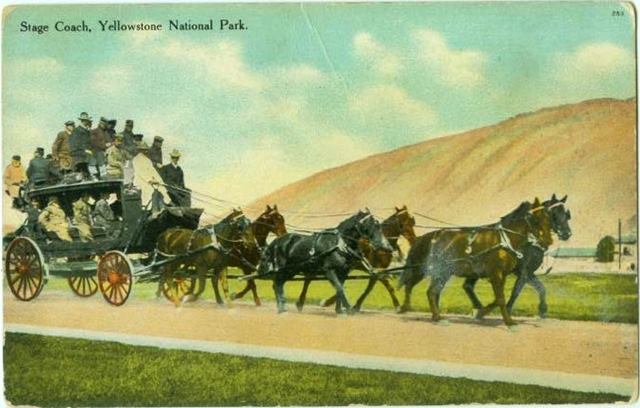 Detroit Publishing Co. Post Card #72809, author's collection
Detroit Publishing Co. Post Card #72809, author's collection |
|
|
With the purchase of the YPA hotel system in 1901 and the deaths of S.S. Huntley in 1901 and E.W. Bach in 1904, Harry Child gained control of all the park concessions save the camping company operations. In 1905, A.W. Miles and A.L. Smith bought W.W. Wylie and gained control of the Wylie Permanent Camping Company, with Harry Child as a silent partner.
.Automobiles were officially allowed into Yellowstone on August 1, 1915, and Child resisted converting over his fleet of 'weed-burners` until 1917 when government mandated the conversion to motorized vehicles. Late in the fall of 1916, all of the transportation operations were to be consolidated into one company operating under a monopoly lease. These companies, which included Frank Haynes` Yellowstone & Western Stage Co., Cody-Sylvan Pass Motor Co., and the Wylie and Shaw & Powell camping company coaches, came under the control of YPTCo and Harry Child. Child arranged with the White Motor Company to purchase 117 10-passenger auto stages to be used in the park beginning in 1917.
(See my "White Buses in YNP" web age for the continuation of this story . . . )
|
____________________________________________________________________________________________________________________________
|
Stagecoach Robberies in Yellowstone:
(1) 7/4/1887 - Near Split Rock in Gardiner Canyon - 1 stagecoach.
(2) 8/14/1897 - 3 miles west of Canyon Hotel - 6 coaches and 1 military wagon robbed.
(3) 8/24/1908 - Near Turtle Rock in Spring Creek Canyon on Craig Pass - 17 stagecoaches and 8 wagons.
(4) 7/29/1914 - Shoshone Point on Craig Pass - 15 coaches.
(5) 7/9/1915 - 1 mile south of Madison Jct. - 5 coaches.
|
Reward Poster, 1908
Courtesy Library of Congress
|
Perhaps the greatest stagecoach hold-up in Yellowstone occured on Aug 24, 1908, near Turtle Rock, enroute from Old Faithful Inn to Lone Star Geyser and Lake Hotel A single bandit held up 17 coaches and wagons. Upon completetion of his dastardly deed, the hold-up man escaped and was never captured. In an excerpt from the 1908 Yellowstone National Park annual report, the Park Superintendent briefly describes the robbery:
"The unfortunate event, the hold-up of seventeen coaches, surreys, and spring wagons on August 24, and the robbery by one man or many of the passengers therein at a point on the main road between Old Faithful Inn and the Thumb of Lake Yellowstone, and about 4 1/4 miles distant from the former, took place about 9 a. m. on August 24 . . . Four of the looted coaches belonged to the Yellowstone Park Transportation Company, five to the Monida and Yellowstone Stage Company, and eight to the Wylie Permanent Camping Company. As near as can be learned by the separate memoranda handed in by the passengers the losses sustained by them in the robbery aggregated $1,363.95 cash and $730.25 in watches and jewelry. Upon being liberated the first coach of those robbed drove rapidly to the camp of the road sprinkling crew, located about 2 miles east of the hold-up point, where notice was given and a messenger dispatched to Old Faithful Inn—distant 6 miles—with news of the robbery." |
Upon safe arrival at the Lake Camp, members of the Wylie Camping Company involved in the robbery reflected on their escapade as what would no doubt be the most exciting adventure of their lives. Mr. H.B. Mitchell of Great Falls describes their meeting that evening:
“That evening [24Aug1908] we had a meeting of the sufferers ait the lakeside hotel, and adopted resolutions which have already been published . . . “The American people have the faculty of seeing the humorous side of even a serious matter, and this case was no exception. The holdup man was hardly out of sight before we were laughing at each other, and the various incidents that had not seemed so funny while the man had his gun upon us. Besides the association mentioned above, the Wiley [Wylie] tourists organized the "Lone Star Involuntary Benevolent association" in memory of the occasion, and for the fun we could get out of it. I was elected president and the ‘Not on Your Life’ girl, as she was called for the rest of the trip, secretary. We had our inaugural meeting around the camp fire with toasts by various members of the suffering party, songs written for the occasion and general jolity." [Great Falls Tribune, 29Aug1908, p5]
Mr. and Mrs. Mitchell reached Butte yesterday. He had the honor of being elected president of the “Lone Star Involuntary Benevolent association," a society to which only those traveling with the Wylie company and who were in the hold-up are entitled to membership. This organization celebrated the event with speeches and much merry-making the evening of the affair at the Lake Hotel camp and still look back upon the hold-up as the real event of their trip. Mr. Mitchell said those In the holdup look back upon it as something not to have been missed—the real event of the trip, and one never to be forgotten.
[Anaconda Standard, 28Aug1908]
The "Not on Your Life" girl mentioned previously is explained by Mr. Mitchell:
"In the last coach were five ladies besides the driver. The first one was Miss Stasia Riley, of Austin, Minn. He demanded her money. *Not on your life,” replied Miss Rilev. 'Here’s a dollar,. and that’s all you set from me." Evidently he admired the nerve for he passed to the next without further demands." [Great Falls Tribune, 29Aug1908, p5] |
Stage Robbery 30Jul1914
Daily Ardmorite, OK
|
Stage Robbery 16Jul1915
Glascow Courier, MT
|
|
Stage Robbery 9Jul1887
Yellowstone Journal
|
Stage Robbery 15Aug1897
Los Angeles Herald
|
Stage Robbery 25Aug1908
Billings Daily Gazette
|
|
Holm Transportation Co.
This outfit was formed by Aron 'Tex` Holm in 1903 and was permitted to operate stagecoaches through the newly opened east entrance road over Sylvan Pass from Cody, Wyoming. Visitors arrived to Cody by train on the Chicago, Burlington, & Quincy RR and transported into and around Yellowstone. Holm had secured an agreement with the railroad to handle all their Yellowstone visitors in 1904. In 1906 Holm and F.H. Welch were permitted to conduct camping parties through the park using wagons and saddle horses.
The company received annual lease from Interior beginning in March of 1912 and established camps at various park locations. Each location included cabins for dining rooms, kitchens, stables, and storerooms. Camps were located at Sylvan Lake, West Thumb, Norris Geyser Basin (NE of Gibbon R. Bridge), Upper Geyser Basin (1800` SE of the OFI dining room), and Canyon (near the Whittaker Store). In 1914 the Holm Co. lease was extended for three years.
(See my "Holm Camping Company" web page for additional information)
|
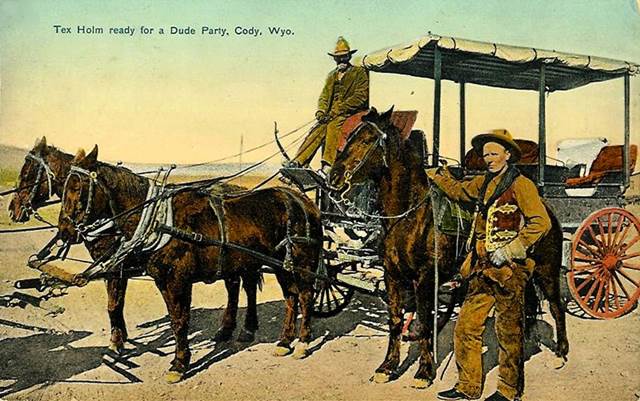
"Tex" Holm and Carriage
Post Card, nd, #D8800
Author's Collection
|
|
Holm Lodge Post Card
Tammen 91671
Author's Collection
|
By 1914 Holm was having some financial difficulties and William F. Cody applied to the park to take over the concession the following year. However, Cody’s request was not acted upon and Holm temporarily revived and continued service through the 1915 season. However, by that time the company had gone bankrupt and was unable to operate the following season, leaving no service provider from Cody and the east entrance into Yellowstone. To alleviate this situation, the Park Service authorized the creation of the Cody-Sylvan Pass Motor Co. for the 1916 season. This company became the first commercial motorized transportation concern allowed into the park and it journeyed from the Chicago, Burlington & Quincy railroad depot in Cody to Lake Hotel where passengers were loaded onto Yellowstone Park Transportation Co stagecoaches for travel into the interior of the park.
(See my White Buses in YNP page for the continuation of this story . . .)
|
Copyright 2018 by Robert V. Goss. All rights reserved.
No part of this work may be reproduced or utilized in any form
by any means, electronic or mechanical, including photocopying,
recording or by an information storage and retrieval system
without permission in writing from the author
|